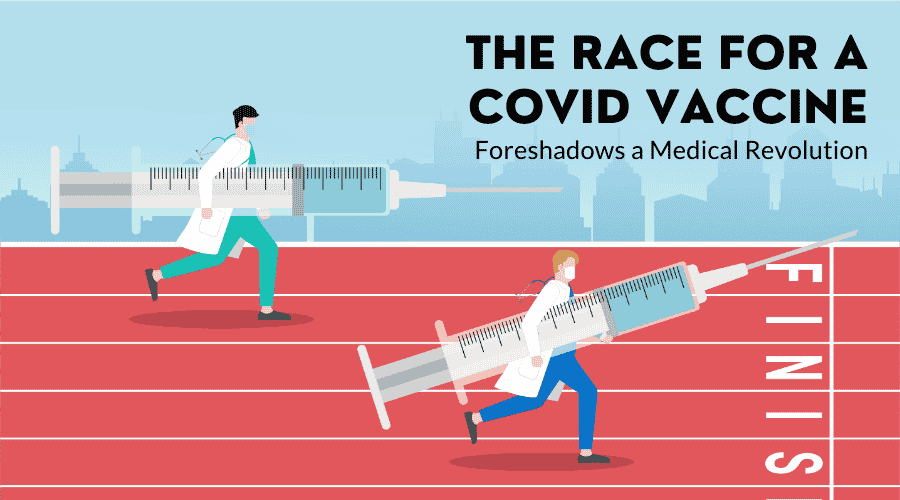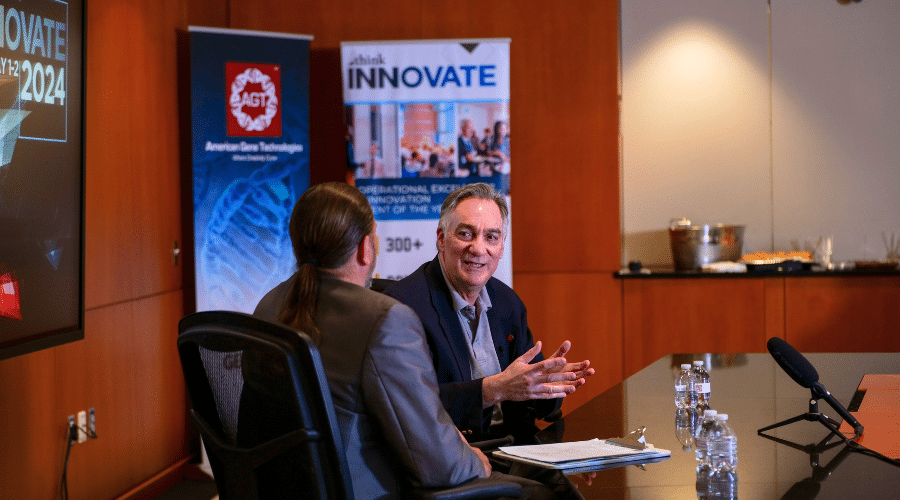The Race for a COVID Vaccine Foreshadows a Medical Revolution


Contributing Author Luke Williams, Sales and Marketing
Conventional vaccine development can take many years, yet vaccines targeting the novel coronavirus were approved and began distribution in under 12 months. Pfizer, Moderna, and AstraZeneca have led the race, announcing promising interim results in their vaccine trials, with Pfizer’s and Moderna’s vaccines showing upwards of 90% effectiveness. The news is filled with updates on the progress of these vaccines, leaving many viewers wondering how they have developed so quickly while the treatments for other diseases seem to perpetually be just a few years away. From the outside looking in, the “normal” timeline of drug development doesn’t reconcile against the breakneck speed of the COVID vaccines, but for those in the know, the development speed of these vaccines is unsurprising. The same genetic technology that drives the mRNA approach to a COVID vaccine has yielded miracle treatments to two formerly incurable blood cancers, Spinal Muscular Atrophy, Lebers Congenital Amorosis, and ACA-SCID, among others. Quietly, biotech firms have been applying genetic technologies to diseases that traditional medicine has failed to address, and now that the COVID vaccines are in the spotlight, public attention is being turned to the genetic revolution.
Biotechnology is a field riding a wave of innovation, and the development speed of the COVID vaccines showcase the ability for the core technology to produce highly efficacious treatments at unprecedented speed. The accelerated timeline of genetic therapeutics translates to a sharp drop in the cost of R&D for new treatments, which has a ripple effect though the economics of healthcare. The COVID vaccines are just the tip of the iceberg, providing visibility to a new class of therapeutics, treatments, and cures that will offer tremendous life extension and profound increases in quality of life. The way these technologies improve healthcare in the coming years may mimic the arc of the computer revolution. Ubiquitous use of computers innervated the world, improved global communications, and enhanced knowledge work which changed the way we live. Similarly, as genetic medicine becomes as commonplace as a smartphone, applications that address cancers, infectious disease, and inherited disorders will change the way we care for patients and transform the pharmaceutical industry into a highly competitive industry that delivers value in a new way.
The arc of the COVID vaccine is high-paced story with origins that predate the COVID-19 pandemic. It was not long ago when science advanced to the point where we could observe biological mechanics at the microscopic scale. Even more recently, the Human Genome Project provided scientists with a flood of data that could be used to develop therapeutics. As the research base grew, the price of genetic sequencing plummeted, providing financial access to the field of genetic medicine and yielded a powerful new set of biological tools. Using these tools, scientists were able to isolate the genetic sequence that encodes the characteristic spike protein on the surface of SARS-CoV-2 within weeks of first contact. Fast forward 11 months to November 2020, and the spike protein sequence can be found in every frontrunning vaccine candidate and may just be the key to ending the first pandemic of this century.
These vaccines are advancing in an environment where rapid drug development is becoming the norm. Standing atop mountains of fundamental research, the world has gone from first contact at the beginning of 2020 to preparing a vaccine for the market in about one year; that’s fast. The previous record holder was the Mumps vaccine with a time-to-market of 4 years.[1] The record-shattering design time of the COVID vaccines showcase the speed and precision of the R&D process for genetic drugs. Each of these vaccine candidates carry RNA that instructs host cells to build the spike protein, which the immune system can use to bolster its defenses against future intruders that express it. Armed with the viral genome, researchers were able to design vaccine candidates within weeks of first contact and begin the testing, scaling and regulatory tasks necessary to advance their vaccine candidate.
The genetic technology platforms that enabled such rapid vaccine development promise to accelerate the availability of genetic vaccines, gene & cell therapies, and immuno-oncology applications. Many of these futuristic methods of treatment are already being tested in clinical trials, and a few have already been approved to treat inherited disorders and several forms of cancer. With the COVID vaccines on a fast track, we may see genetic medicine take down a virus for the first time. Viral vectors, designer genes, and siRNA mechanisms have put viral diseases in the crosshairs of gene and cell therapy. Hot on the heels of SARS-CoV-2, we hope to see HIV fall to AGT103-T, a gene & cell therapy designed to be a functional cure for HIV. Looking forward, these technologies will be further developed and adapted to address a continually expanding range of serious human diseases. Thus, ushering in a renaissance of healthcare with profound benefits in longevity and quality of life for millions of patients.
Under normal circumstances, creating new treatments is a triathlon of design, clinical trials, and large-scale production that can take decades. The 88+ gene & cell therapy ‘triathletes’ in this race have strong advantages compared to traditional medicines. Their design phase rides atop a wave of genomic data, their clinical race shortcuts through pivotal trials and pre-approved design elements, and they quickly scale production with support from the layered biotech industry. Technology is changing the triathlon, and nimble biotech firms are facilitating the delivery of highly effective medicines to the public faster than ever before. As genetic medicines, the COVID vaccines enjoy all these inherent benefits, plus a regulatory fast track that warps the track in front of them, compressing the race to a fraction of its actual length. With or without a regulatory fast track, the COVID vaccines are unignorable indicators that the disruption of the pharmaceutical industry is already in motion. Technology has changed the triathlon, and as speed records are shattered in each leg of the race, the full momentum of the genetic revolution becomes apparent. While the analogy tracks, reality beckons: this is no foot race. Economies, happiness, health, and lives are at stake; every second counts.
References
[1] D. Roos, "How a New Vaccine Was Developed in Record Time in the 1960s", HISTORY, 2020. [Online]. Available: https://www.history.com/news/mumps-vaccine-world-war-ii. [Accessed: 15- Dec- 2020].





